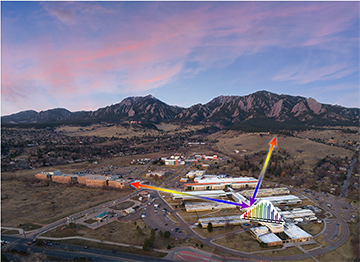NIST researchers used a laser frequency-comb instrument (illustration at lower right) to simultaneously measure three airborne greenhouse gases—nitrous oxide, carbon dioxide and water vapor—plus the major air pollutants ozone and carbon monoxide over two round-trip paths (arrows) from a NIST building in Boulder, CO, to a reflector on a balcony of another building and another reflector on a nearby hill. [Image: N. Hanacek/NIST] [Enlarge image]
For more than two decades, optical frequency combs have contributed to better atomic clocks, more efficient optical communications systems and molecular fingerprinting tools, among other applications. John Hall of JILA, a joint institute of the National Institute of Standards and Technology (NIST) and the University of Colorado at Boulder, USA, and Theodor Hänsch of the Max Planck Institute for Quantum Optics, Germany, shared the 2005 Nobel Prize in physics for their development of frequency-comb spectroscopy.
Now, researchers at NIST have built a laser frequency-comb instrument that can simultaneously measure three airborne greenhouse gases—nitrous oxide, carbon dioxide and water vapor—along with two common air pollutants, ozone and carbon monoxide (Laser Photon. Rev., doi: 10.1002/lpor.202000583). The instrument, the researchers say, provides a precise way to monitor the atmosphere around oil and gas installations, agricultural sources and urban areas to address the challenges and implications of climate change.
Two combs are better than one
An optical frequency comb is a laser source whose spectrum consists of a series of very precisely defined, evenly spaced frequencies. The many frequencies enable measurements of the characteristic absorption signatures of different gas molecules.
Previously, the team at NIST had created an open-path, dual-comb spectroscopy system in the near-infrared at the spectral region around 1.6 microns that could measure methane, carbon dioxide, water vapor and air temperature. By exploiting the interference of two identical frequency combs, dual-comb spectroscopy has advantages over traditional frequency comb spectroscopy in terms of spectral resolution, sensitivity and data acquisition speed.
“The dual-frequency-comb system uses an emerging technology that combines a couple of nice features to give us reasonably broad spectral coverage, so we can measure a bunch of different gases at the same time,” says lead author Kevin Cossel. “What we wanted to do was extend the wavelength coverage to this region between 4.5 to 5 microns.”
Upgrading the instrument
Cossel and his colleagues first extended the instrument to the 3-micron region, which gave them access to the characteristic absorption spectra of several additional organic compounds. Next, they upgraded some of the optics and spectral broadening components to allow for operation in the mid-infrared, 5-micron atmospheric window, primarily to target nitrous oxide. In particular, the system employed a specially engineered crystal material called periodically poled lithium niobate to convert near-infrared light to a lower frequency.
“[Nitrous oxide] is often referred to as the forgotten greenhouse gas, but it is the third most prevalent anthropogenic greenhouse gas,” says Cossel. “The bulk of it comes from agriculture, and there’s also emissions from vehicles. But inventories and knowledge about how to manage emissions are not as well known.”
The researchers demonstrated the capabilities of the instrument by making open-path measurements across a 600-m-long, round-trip path that stretched from the top of the NIST building in Boulder, CO, to the balcony of the National Oceanic and Atmospheric Administration (NOAA) building. Sensitivities hovered around two parts per billion or less for most gases and showed good agreement with a NOAA point sensor that recorded nitrous oxide, carbon monoxide and water vapor.
An all-in-one instrument
With this new instrument, NIST’s dual-comb spectroscopy technology can now sense all four primary greenhouse gases, as well as carbon monoxide and ozone. However, the researchers still need to operate two separate instruments to do so. Their long-term goal is to combine the two wavelength regions, near-infrared and mid-infrared, into one system, based on the same concept.
“[We’re looking forward to] being able to apply the system to agriculture, and also having the ability to measure ozone and carbon monoxide with the system, which has applications for looking at emissions from wildfires and urban air quality,” Cossel says. “So we’ll be targeting those applications, along with emissions from oil and gas drilling and greenhouse gases.”

